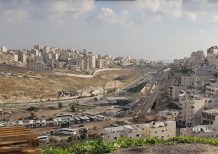Successful struggle in East Jerusalem

The decade-long struggle of Bimkom and Palestinian residents against a planned massive landfill in East Jerusalem succeeded, when in late December 2023 the plan for a substantially smaller landfill was instead deposited. The demolition of over 70 structures, including residential ones, and the forcible eviction of some 150 Bedouin residents from the planned site was thus prevented. The new plan covers just a fifth of the area initially allotted and only 4-7% of the landfill volume originally envisaged.
Already in the first planning committee discussions in 2012, Bimkom argued that a landfill for construction debris should not be planned in East Jerusalem and that this site was selected for reasons unrelated to planning. The state’s underlying assumption was that East Jerusalem’s occupied and weakened Palestinian population would not object to a massive landfill near a residential area, or that their objections could be ignored.
An updated landfill plan (Plan 101-1003532), submitted for objections in 2022, encompassed an open valley bordering on the built-up area of East Jerusalem neighborhoods al-Isawiyyah, Anata and Ras Shahada. It was also near the Shu’fat refugee camp and Ras Khamis neighborhood, which together are home to tens of thousands of Palestinians. The original landfill plan included demolition of over 70 buildings, including residential ones, and covered land that was mostly Palestinian owned. The planned site would have also caused environmental damage, transforming the natural topography from a deep valley into a large hill.
Bimkom worked against the planned landfill site for over ten years together with a committee of residents from al-Isawiyyah, Anata, Ras Shahada and the Bedouin families at risk of forcible eviction from the area.
Bimkom Co-Director and architect Efrat Cohen Bar, who worked against the landfill plan from the beginning, notes that “The originally planned landfill for construction debris from Israeli neighborhoods is a finger in the eye of East Jerusalem residents. Israel severely restricts development and construction in Jerusalem’s Palestinian neighborhoods – the only construction waste created there is from Israel’s home demolitions, and not from development projects. It was unjust to plan such a polluting site on privately-owned land in East Jerusalem, close to residential areas. I have great respect for the East Jerusalem residents who struggled more than a decade and succeeded in almost entirely eliminating the landfill.”
Hani Issawi, a member of the residents’ committee, said: “The struggle was long, and we had hoped to abolish the entire plan, which confiscates private land and harms several neighborhoods. Although we were unable to completely eliminate the plan, reducing the landfill’s size does decrease the damage it will cause. The most important achievement is that the homes of our Bedouin neighbors are no longer included in the plan and will not be demolished.”
The decade-long struggle of Bimkom and Palestinian residents against a planned massive landfill in East Jerusalem succeeded, when in late December 2023 the plan for a substantially smaller landfill was instead deposited. The demolition of over 70 structures, including residential ones, and the forcible eviction of some 150 Bedouin residents from the planned site was thus prevented. The new plan covers just a fifth of the area initially allotted and only 4-7% of the landfill volume originally envisaged.
Already in the first planning committee discussions in 2012, Bimkom argued that a landfill for construction debris should not be planned in East Jerusalem and that this site was selected for reasons unrelated to planning. The state’s underlying assumption was that East Jerusalem’s occupied and weakened Palestinian population would not object to a massive landfill near a residential area, or that their objections could be ignored.
An updated landfill plan (Plan 101-1003532), submitted for objections in 2022, encompassed an open valley bordering on the built-up area of East Jerusalem neighborhoods al-Isawiyyah, Anata and Ras Shahada. It was also near the Shu’fat refugee camp and Ras Khamis neighborhood, which together are home to tens of thousands of Palestinians. The original landfill plan included demolition of over 70 buildings, including residential ones, and covered land that was mostly Palestinian owned. The planned site would have also caused environmental damage, transforming the natural topography from a deep valley into a large hill.
Bimkom worked against the planned landfill site for over ten years together with a committee of residents from al-Isawiyyah, Anata, Ras Shahada and the Bedouin families at risk of forcible eviction from the area.
Bimkom Co-Director and architect Efrat Cohen Bar, who worked against the landfill plan from the beginning, notes that “The originally planned landfill for construction debris from Israeli neighborhoods is a finger in the eye of East Jerusalem residents. Israel severely restricts development and construction in Jerusalem’s Palestinian neighborhoods – the only construction waste created there is from Israel’s home demolitions, and not from development projects. It was unjust to plan such a polluting site on privately-owned land in East Jerusalem, close to residential areas. I have great respect for the East Jerusalem residents who struggled more than a decade and succeeded in almost entirely eliminating the landfill.”
Hani Issawi, a member of the residents’ committee, said: “The struggle was long, and we had hoped to abolish the entire plan, which confiscates private land and harms several neighborhoods. Although we were unable to completely eliminate the plan, reducing the landfill’s size does decrease the damage it will cause. The most important achievement is that the homes of our Bedouin neighbors are no longer included in the plan and will not be demolished.”
